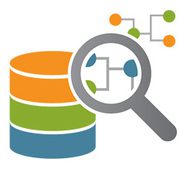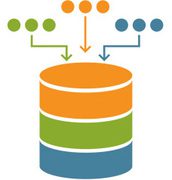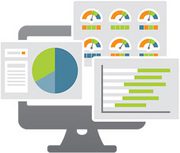
Part 1. Business scenarios.
I have spent many hours planning and executing in-company self-service BI implementation. This enabled me to gain several insights. Now that the ideas became mature enough and field-proven, I believe they are worth sharing. No matter how far you are in toying with potential approaches (possibly you are already in the thick of it!), I hope my attempt of describing feasible scenarios would provide a decent foundation.
All scenarios presume that IT plays its main role by owning the infrastructure, managing scalability, data security, and governance.
Scenario 1. Tableau Desktop + departmental/cross-functional data schemas.
 This scenario involves gaining insights by data analysts on a daily basis. They might be either independent individuals or a team. Business users’ interaction with published workbooks is applicable, but limited to simple filtering.
This scenario involves gaining insights by data analysts on a daily basis. They might be either independent individuals or a team. Business users’ interaction with published workbooks is applicable, but limited to simple filtering.
User categories: professional data analysts;
Technical skills: intermediate/advanced SQL, intermediate/advanced Tableau;
Tableau training: 2-3 days full time (preferably) or continuous self-learning from scratch;
Licenses: Tableau Desktop.
Pros:
- Pure self-service BI approach with no IT involved in data analysis;
- Vast range of data available for analysis with almost no limits;
- Fast response for complex ad-hoc business problems.
Cons:
- Requires highly skilled data analysts;
- Most likely involves Tableau training on query performance optimisation on a particular data source (e.g. Vertica).
Advice:
- Create a “sandbox” that allows data analysts to query and collaborate on their own and without supervision. Further promotion of workbooks to production is welcome.
Scenario 2. Tableau Desktop + custom data marts.
 In this scenario, business users are fully in charge of data analysis. IT provides custom data marts.
In this scenario, business users are fully in charge of data analysis. IT provides custom data marts.
User categories: business users, line-managers;
Technical skills: basic SQL, basic/intermediate Tableau;
Tableau training: two or three 2-3h sessions + ad-hoc support on daily basis;
Licenses: Tableau Desktop + Server Interactors.
Pros:
- Easy access to data for ad-hoc analysis;
- Self-answering critical business questions;
- Self-publishing for further ad-hoc access across multiple devices.
Cons:
- Adding any data involves IT support;
- Requires elaborated data dictionaries.
Advice:
- Make requirements gathering a collaborative and iterative process with regular communication. That would ensure well-timed data delivery and quality;
- Deliver training in 2-3 wisely structured sections with 2-3 week breaks for business users to have time for playing with software, along with generating needs for the new skills.
- Focus on reach visualisations, not tables.
Scenario 3. Tableau Server Web Edit + workbook templates
 This scenario fully relies on data models published by data analysts and powerful Web Edit features of Tableau Server.
This scenario fully relies on data models published by data analysts and powerful Web Edit features of Tableau Server.
User categories: line-managers, top managers;
Technical skills: Tableau basics;
Tableau training: one 30 min demo session + ad-hoc support;
License: Server Interactor.
Pros:
- No special training;
- Fast Tableau adoption with basic, but powerful Self-service BI capabilities (Web Edit);
- Thin client access via any Desktop Web Browser;
- Could serve as a foundation for self-service BI adoption among C-Suite.
Cons:
- High level of accuracy for data preparation and template development;
- Any changes in the data model require development and republishing of a template.
Advice:
- Try to select the most proactive and “data hungry” line manager or executive, who could help to spread the word;
- Investigate analytical needs, ensure availability of a subject matter expert;
- Start with simple visualisations, but be ready to increase complexity;
- Provide as much ad-hoc assistance as you can.
In my next post, I would like to throw light on some technical aspects and limitations of each scenario.
I highly appreciate any comments and looking forward to know about your experience.
Save
